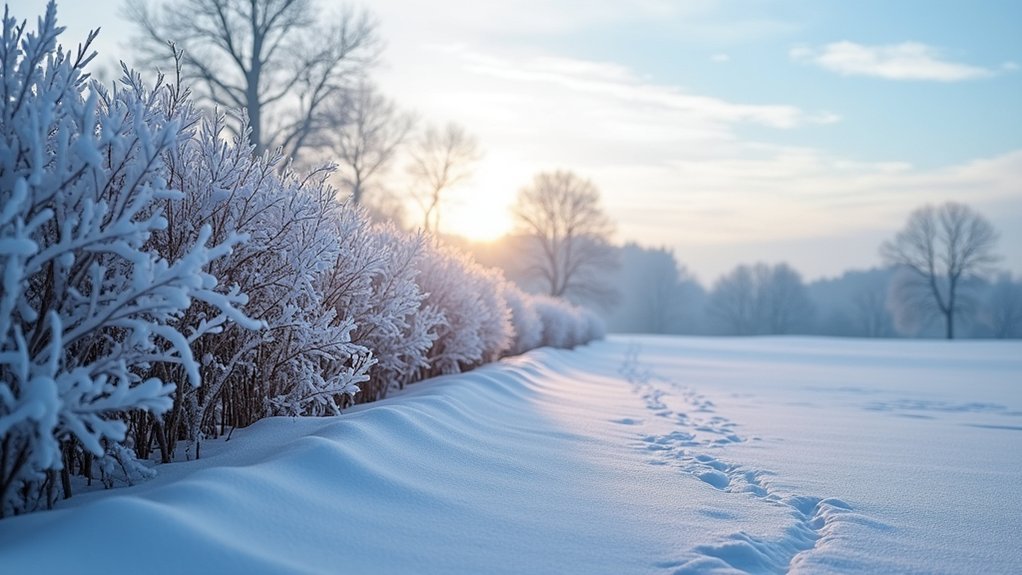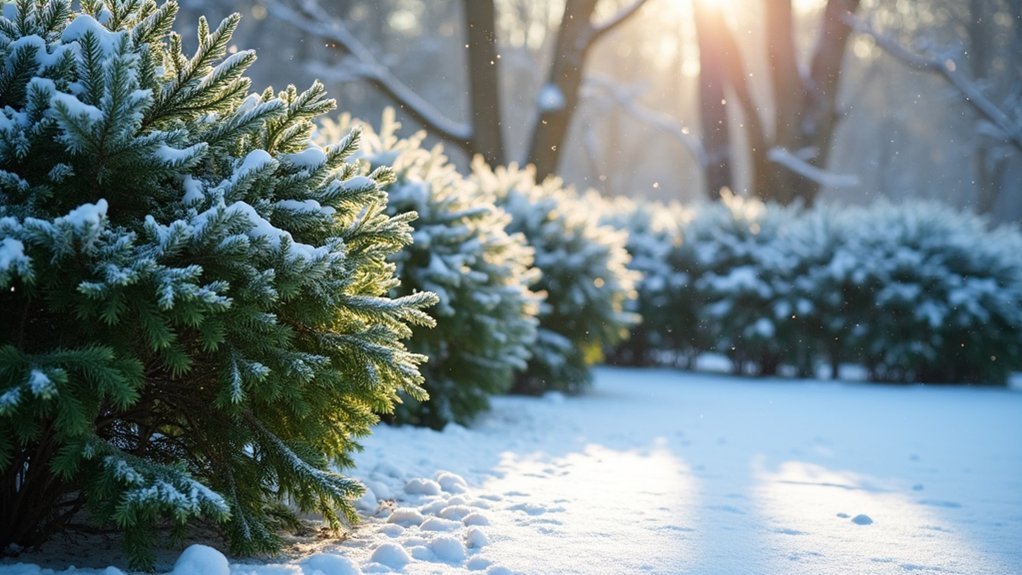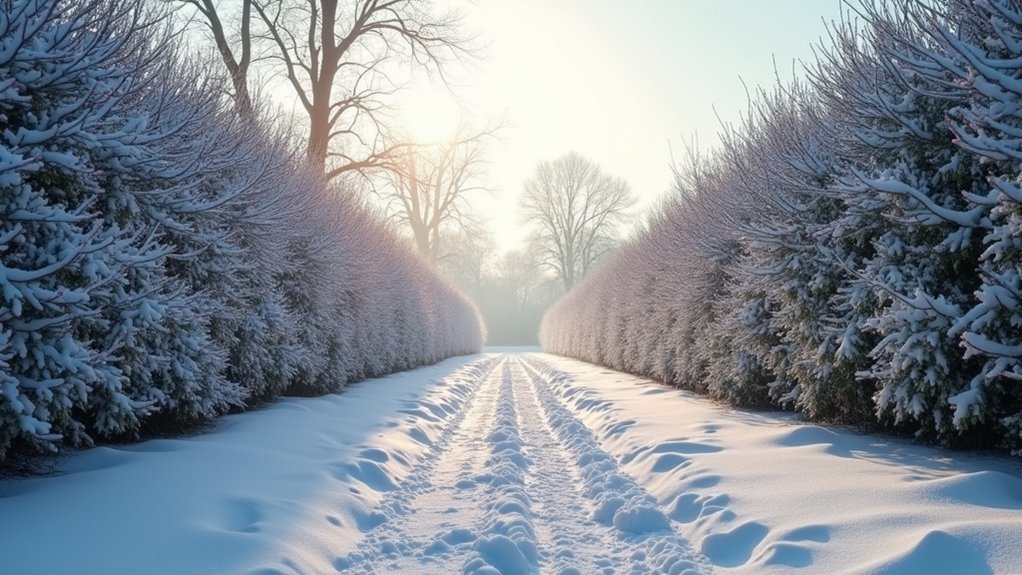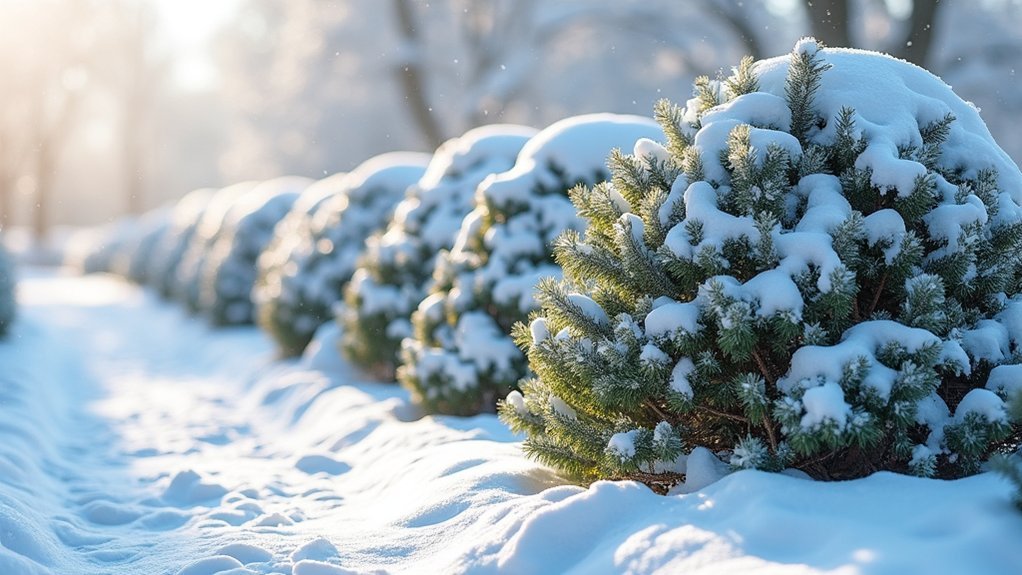Flexible hedges provide natural barriers against heavy snow with their pliable branches that bend rather than break under weight. You’ll benefit from their snow-shedding capabilities, which reduce removal efforts and maintenance costs. Species like boxwood, junipers, and arborvitae are particularly effective when positioned 80-120 feet from driveways. Beyond snow management, these hedges create essential wildlife habitats and foster biodiversity. The strategic advantages of these living snow fences extend far beyond their beautiful appearance.
11 Second-Level Headings for “Why Choose Flexible Hedges For Snowy Areas?”

When planning your winter landscape, understanding the advantages of flexible hedges can save you significant time and resources.
These specially designed plants create effective natural barriers that handle heavy snow better than rigid alternatives.
Flexible hedges, particularly coniferous evergreens, naturally shed snow and ice due to their shape and pliable branches. They’ll bend under winter’s weight without breaking, then bounce back when the snow melts.
You’ll appreciate how they function as living snow fences, trapping drifts strategically and reducing your snow removal efforts.
Regular pruning maintains their tight structure, enhancing their snow-shedding capabilities and protecting them from winter damage.
Beyond their practical benefits, these hedges increase biodiversity, provide wildlife habitats, and maintain visual interest throughout snowy seasons—giving you both functionality and beauty in your winter landscape.
The Science Behind Flexible Branch Resilience
Unlike rigid branches that snap under winter’s burden, flexible hedge branches have evolved remarkable structural adaptations that allow them to survive heavy snow loads. This resilience stems from their unique composition of pliable fibers and a robust cambium layer that absorbs stress without breaking.
Nature’s ingenious design allows flexible hedge branches to dance with winter’s weight rather than surrender to it.
When examining trees and shrubs like boxwood and arborvitae, you’ll notice their branches bend gracefully under snow weight rather than fracturing. This natural flexibility enables them to return to their original position once the snow melts.
Coniferous evergreens enhance this capability with their conical shape, which efficiently sheds snow.
Research confirms that flexible branches maintain structural integrity even after bearing substantial snow accumulation. By incorporating these naturally resilient plants into your landscape and maintaining them properly, you’ll enjoy hedges that withstand winter’s challenges year after year.
Top Snow-Resistant Hedge Species to Consider

Selecting the right hedge species can mean the difference between a pristine winter landscape and broken, splayed plants after heavy snowfall.
Boxwood and junipers stand out as exceptionally snow-resistant options due to their flexible branches that bend rather than break under snow’s weight.
Arborvitae offers another excellent choice with its natural conical shape that efficiently sheds snow.
If you’re seeking boundary hedges, consider privet with its robust structure specifically designed to withstand heavy snow loads.
Yew hedges provide dual benefits: attractive winter interest and effective snow-shedding capabilities that minimize breakage.
For best results, you’ll find that planting a diverse mix of these snow-resistant hedge species not only enhances biodiversity but also guarantees your landscape remains intact throughout even the harshest winter conditions.
Creating Natural Snow Barriers With Living Fences
While traditional fences merely mark boundaries, living fences transform your property’s perimeter into strategic snow management systems. When properly placed 80-120 feet upwind of driveways, these natural barriers trap snow about 20 times their height downwind, preventing drifts from blocking your access.
For maximum effectiveness with living fences:
- Maintain a 6-inch gap underneath to optimize snow accumulation and protect soil from deep freezing.
- Plant a mix of tall and short native shrubs to create layered snow trapping while supporting local wildlife.
- Select winter-hardy varieties like elderberries or service berries that withstand harsh conditions while adding visual appeal.
These strategic plantings work smarter than conventional barriers, harnessing natural processes to control snow while enhancing your landscape’s biodiversity and resilience.
Comparing Flexible vs. Rigid Hedges in Winter Conditions

When heavy snow blankets your landscape, the difference between flexible and rigid hedges becomes strikingly apparent.
Flexible hedges, particularly coniferous evergreens, naturally bend under snow’s weight, preventing the branch breakage that often plagues rigid hedges in winter conditions.
Coniferous evergreens bow gracefully beneath winter’s white burden while rigid hedges snap under pressure.
You’ll notice that snow slides off flexible hedges more easily due to their natural shape, promoting healthier growth and reducing post-storm maintenance.
While rigid hedges frequently require additional support during winter storms, flexible varieties typically recover without intervention.
An unexpected benefit: flexible hedges allow snow to accumulate around their base, insulating roots against extreme cold.
Maintenance Tips for Snow-Resistant Hedge Varieties
Proper maintenance of snow-resistant hedges greatly extends their lifespan in harsh winter climates.
When caring for flexible hedge varieties like boxwood and junipers, prune them slightly wider at the base to promote natural snow shedding and reduce branch strain.
Perform regular inspection throughout winter to identify and remove damaged limbs, which prevents further issues and encourages healthy growth when spring arrives.
Before heavy snowfall begins, consider these essential preventative measures:
- Wrap smaller upright shrubs with biodegradable twine for additional support
- Gently brush off accumulated snow after storms to prevent excessive weight
- Maintain a wider base than top when pruning to facilitate natural snow shedding
These simple maintenance practices will help your snow-resistant hedges maintain their structure and health throughout challenging winter conditions.
Design Strategies for Multi-Seasonal Hedge Appeal

You’ll want to combine evergreens and deciduous shrubs in your hedge design to create visual interest through varying textures as seasons change.
Mix plants that offer distinctive winter silhouettes with those displaying vibrant autumn colors or spring flowers for year-round appeal.
Consider how the structural elements of your hedge will look when outlined with snow, creating dramatic contrasts that transform your winter landscape into a living sculpture.
Seasonal Texture Variations
Creating a hedge that remains visually striking throughout all seasons requires thoughtful planning and strategic plant selection.
Combine evergreen shrubs for winter structure with deciduous varieties that showcase colorful foliage changes. Proper pruning with a wider base enables better snow shedding while maintaining an appealing year-round silhouette.
You’ll notice dramatic texture changes as your hedge responds to seasonal shifts:
- Spring/Summer – Varied leaf textures, blooms, and vibrant growth patterns create visual interest
- Fall – Deciduous plants display rich color transformations before leaf drop
- Winter – Flexible branches of boxwood and junipers bend gracefully under snow, while persistent berries and interesting bark textures become prominent
This layered approach not only attracts wildlife but guarantees your hedge maintains its aesthetic appeal regardless of season or snowfall.
Color Through Seasons
When designing a hedge that dazzles year-round in snowy regions, strategic color planning becomes essential for maintaining visual interest across all seasons.
Combine deciduous and evergreen species to create a dynamic palette that evolves throughout the year. While deciduous varieties offer vibrant spring and summer foliage, evergreens provide structural consistency and color during winter months when snow blankets the landscape.
Consider incorporating flowering shrubs like currants and elderberries that attract wildlife while adding bursts of seasonal color. The contrast between dark green evergreen foliage and pristine white snow creates a striking visual effect that transforms your winter garden from barren to breathtaking.
Implement seasonal pruning to shape your hedge’s growth patterns, encouraging diverse textures and colors that shift with the changing seasons. This ensures your landscape remains visually engaging regardless of the weather.
Wildlife Benefits of Flexible Hedge Installations
Three distinct wildlife advantages emerge when flexible hedges are installed in snowy regions. Your native shrub hedges will create essential habitats for local birds, supporting biodiversity through their intricate structure.
These natural barriers offer protection against harsh winter winds, notably reducing stress on wildlife while ensuring they can access food sources with minimal effort.
Flexible hedges also contribute to wildlife survival by:
Resilient hedges create vital winter sanctuaries, fostering biodiversity when wildlife needs it most.
- Creating dense shelter for small mammals and insects, establishing a balanced ecosystem
- Forming microclimates by trapping snow, helping flora and fauna survive extreme cold
- Enriching soil through organic matter decomposition, supporting diverse feeding opportunities
When you install flexible hedges, you’re not just landscaping—you’re creating a wildlife sanctuary that thrives even during the harshest winter conditions.
Cost Analysis: Long-Term Savings With Resilient Hedges

While the initial cost of installing flexible, snow-resistant hedges may seem higher, you’ll experience significant savings over their lifetime through reduced replacement and repair expenses.
You’ll cut maintenance costs further as these resilient plants bend rather than break under heavy snow loads, eliminating the need for frequent pruning and restoration after winter storms.
Your investment in properly selected hedge varieties serves as weather damage prevention, creating windbreaks that lower heating bills and minimize snow removal costs on your property.
Initial vs. Lifetime Costs
Although the upfront cost of flexible hedges may seem steep, they’re actually a smart financial investment for snowy areas. Your initial investment in coniferous evergreens will quickly be offset by long-term savings on maintenance needs, repairs, and replacements.
When calculating true hedge costs, consider these financial advantages:
- Reduced replacement expenses – flexible hedges withstand heavy snow loads that would damage traditional shrubs.
- Lower maintenance needs – these resilient plantings require less repair, trimming, and structural support.
- Decreased snow removal costs – properly selected hedges naturally shed snow, minimizing manual clearing expenses.
Government incentives for living snow fences may further offset your costs.
Plus, you’ll enjoy added property value from the year-round aesthetic benefits these sustainable hedges provide—making them an economically sound choice for snowy regions.
Maintenance Expense Reduction
Looking beyond initial investments reveals the substantial maintenance savings flexible hedges offer homeowners in snowy regions. When you choose coniferous evergreens, you’re selecting plants that naturally shed snow, preventing costly branch breakage that plagues less durable varieties.
| Maintenance Task | Cost Impact |
|---|---|
| Storm repairs | Dramatically reduced |
| Pruning damaged limbs | Minimized |
| Winter protection | Nearly eliminated |
| Replacement plants | Rarely needed |
| Professional services | Less frequent |
These resilient hedges don’t require expensive wrapping or support systems during winter months, cutting your seasonal preparation costs. You’ll appreciate spending less on landscaping services as your durable hedges maintain their health and structure year after year. The reduced need for intervention translates directly into long-term financial benefits, making flexible hedges a smart economic choice for snowy climates.
Weather Damage Prevention
Homeowners in snowy regions can dramatically reduce property damage costs when they invest in flexible hedge varieties designed to withstand winter’s worst.
These resilient plants naturally bend under heavy snow loads rather than breaking, providing superior weather damage prevention while saving you money.
Studies show that choosing the right hedges can save approximately $1,000 in storm-related repair costs over ten years.
The financial benefits become clear when you consider:
- Reduced replacement costs as flexible hedges recover naturally after snow weight
- Lower maintenance costs compared to brittle alternatives requiring frequent repair
- Prevention of soil freezing damage when hedges function as living snow fences
Coniferous evergreens offer exceptional flexibility, making them ideal choices for properties that experience substantial snowfall while providing year-round landscape protection.
Combining Dead and Living Hedges for Winter Protection
When winter’s harsh conditions threaten landscape integrity, combining dead and living hedges creates an innovative protective strategy that excels in snowy regions.
Dead hedges, constructed from branches and limbs, provide immediate structural support while creating pockets that trap snow before it drifts across your property.
You’ll find that pairing these structures with living hedges like evergreens and winter-hardy shrubs delivers multiple benefits. This combination not only manages snow effectively but also creates valuable wildlife habitat during barren months.
The layered design allows snow to accumulate strategically, insulating the roots of your living hedges against extreme cold.
This approach to snow management improves your winter landscape aesthetically while establishing a microclimate that promotes plant health long-term—a perfect balance of form and function.
Strategic Placement for Optimal Snow Management
Strategic placement of flexible hedges 80-120 feet from your driveway will create an effective drift control system, capturing snow before it reaches critical areas.
You’ll want to extend your hedges beyond the protection zone and include a 6-inch gap underneath to optimize snow accumulation patterns.
For protecting courtyards and doorsteps, position taller shrubs farther from these spaces, remembering that snow can drift up to 30 times the height of your barrier downwind.
Drift Control Techniques
Mastering the art of drift control begins with proper placement of your flexible hedges. Position your living snow fences 80-120 feet away from driveways to effectively block prevailing winds and manage snow accumulation.
For ideal drift control, verify your hedges are half solid and half open, creating the perfect balance for trapping snow while controlling drift patterns downwind.
Remember these essential techniques for maximum effectiveness:
- Extend hedge length beyond the protected area to better manage snow distribution
- Maintain a 6-inch gap underneath to facilitate accumulation without blocking access
- Plant taller shrubs further back from critical areas to redirect drift patterns
This strategic approach not only protects your property from unwanted snow buildup but also enhances your landscape’s winter functionality and appearance.
Courtyard Protection Strategies
To shield your courtyard from winter’s full force, proper hedge placement becomes your most valuable snow management tool. Position your flexible hedges 80-120 feet from driveways and courtyards to effectively redirect prevailing winds and minimize snow drift accumulation.
Create a strategic design by planting taller shrubs farther from your courtyard, with shorter varieties closer to access points. This tiered approach manages snow accumulation while maintaining clear pathways.
Remember to maintain a 6-inch gap beneath your hedges to enhance snow trapping without allowing buildup against structures.
For enhanced courtyard protection, incorporate bird-friendly options like currants and service berries. These provide not only an effective snow barrier but also winter visual interest.
Regularly assess hedge height to guarantee they’re effectively holding snow while allowing easy courtyard access throughout winter.
Frequently Asked Questions
Can Hedges Survive Winter?
Yes, hedges can survive winter. You’ll find many varieties withstand cold conditions well. Their flexible branches bend under snow rather than break, and they’ll often benefit from snow’s insulating properties on their roots.
How Do You Protect Shrubs From Heavy Snow?
To protect shrubs from heavy snow, plant flexible species like boxwood, wrap them with soft materials in fall, maintain tight shapes through pruning, gently brush off accumulated snow, and inspect after storms for damage.
What Is the Most Hardy Hedge?
The most hardy hedge options include boxwood, arborvitae, and junipers. You’ll find these coniferous evergreens adapt well to cold climates and naturally shed snow due to their shape and flexible branches.
Should You Remove Heavy Snow From Bushes?
Yes, you should remove heavy snow from bushes. It’s essential to prevent branches from breaking under the weight. Gently knock off snow before it accumulates further, but avoid vigorous motions that might damage limbs.
In Summary
You’ve discovered the smart solution to winter landscaping challenges! By choosing flexible hedges for your snowy area, you’re investing in resilient boundaries that bend without breaking, protect wildlife, manage snowdrift, and save money long-term. Whether you’re planting willow, dogwood, or creating living snow fences, these adaptable shrubs will withstand winter’s worst while maintaining your landscape’s beauty year after year.





Leave a Reply